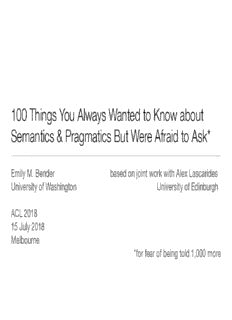
100 Things You Always Wanted to Know about Semantics & Pragmatics But Were Afraid to Ask PDF
Preview 100 Things You Always Wanted to Know about Semantics & Pragmatics But Were Afraid to Ask
100 Things You Always Wanted to Know about Semantics & Pragmatics But Were Afraid to Ask* Emily M. Bender based on joint work with Alex Lascarides University of Washington University of Edinburgh ACL 2018 15 July 2018 Melbourne *for fear of being told 1,000 more Goals • Mine: • Give you a sense of linguistic semantics and pragmatics • Help you make more effective meaning-sensitive natural language technology • Intermediate goal on the way to writing a book ;-) • Yours: • What do you hope to get from this tutorial? • What meaning-sensitive NLT are you working on? • For what languages? Outline • Introduction: What is meaning? • Lexical semantics • Semantics of phrases • Meaning beyond the sentence • Presupposition and implicature • Resources • Wrap-up Outline • Introduction: What is meaning? • Lexical semantics • Semantics of phrases • Meaning beyond the sentence • Presupposition and implicature • Resources • Wrap-up Why semantics and pragmatics? • Understanding semantics and pragmatics is beneficial for building scalable 1 # NLP systems • How do strings of words relate to speaker intent? • General purpose NLU requires modeling that which is general across language • Knowledge of semantics and pragmatics can inform the design of NLP systems for understanding and generation 2 # • Mapping between surface forms and intent representations What is meaning? 3 In part: Validity or truth conditions # All cats are mortal x(cat (x) mortal (x)) 8 ! Euler is a cat cat (e) Euler is mortal mortal (e) • Some words (e.g. all, if, must) map to special logical constants • Others map to non-logical constants • Interpretation of logical formulae (LF) is compositional as is (generally) the translation of natural language expressions to LFs • Validity is relevant for inference and thus RTE, QA, IE What is meaning? 3 In part: Validity or truth conditions # All cats are mortal x(cat (x) mortal (x)) 8 ! Euler is a cat cat (e) Euler is mortal mortal (e) • Some words (e.g. all, if, must) map to special logical constants • Others map to non-logical constants • Interpretation of logical formulae (LF) is compositional as is (generally) the translation of natural language expressions to LFs • Validity is relevant for inference and thus RTE, QA, IE What is meaning? Not just validity or truth conditions • Constructing meaning representations also requires commonsense reasoning: 4 # John can open Bill’s safe. . . . He knows the combination. . . . He should change the combination. (Hobbs 1979) • World knowledge: safes have combinations => the combination is the combination to Bill’s safe. • World knowledge: knowing the combination allows you to open it + coherence (second clause explains first) => He is John • World knowledge: changing combination solves security breach + coherence (first clause explains second) => He is Bill Meaning derived from form is different from meaning derived from context of use • Meaning level 1: Semantics derived from form: What is constant about the meaning of a sentence across different occasions of use A: Is it raining? B: Yes. Meaning derived from form is different from meaning derived from context of use • Meaning level 2: What a speaker publicly commits to by virtue of using a particular form in a particular context A: Is it raining? B: Yes. A: It’s perfectly dry outside. You’re lying. B: #I didn’t say it’s raining.
Description: